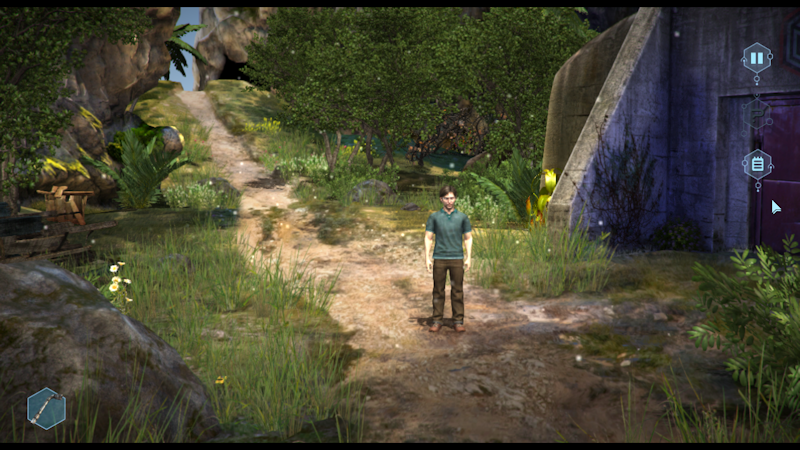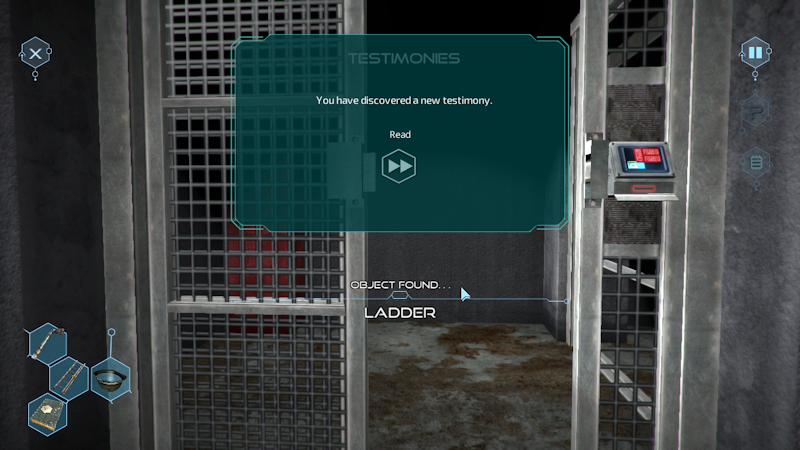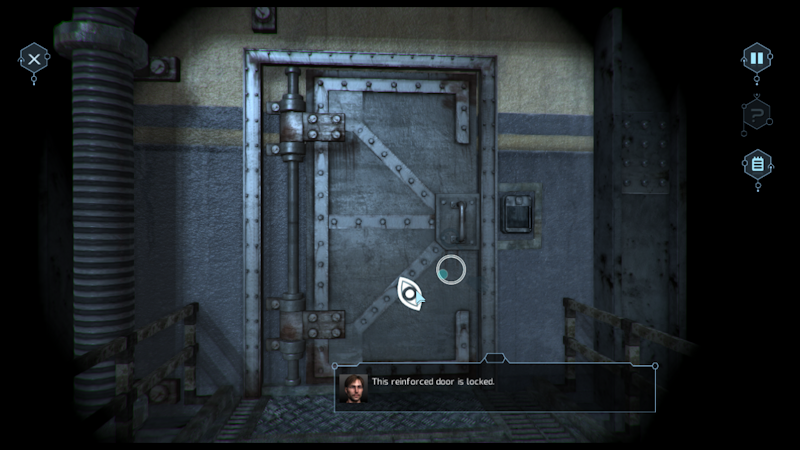Subject 13
| Developer: | Microïds |  The title screen. The title screen. |
| Released: | 2015.05.28 | |
| Genre: | SciFi / Mystery | |
| Graphics: | Realistic / 3D | |
| Perspective: | First person / Third person | |
| Gameplay: | Point-and-Click |
You are underwater. Going deeper down. The next thing you know is that you are sitting in some kind of chamber, and someone is calling you... by the name "Subject 13".
The opening sequence of Subject 13 is short and doesn't reveal much, in fact it raises more questions than what it provides answers for as a background. What exactly is going on is what the player, as Subject 13, has to find out. The protagonist is a man with the name Franklin Fargo, but as the voice who identifies itself as "Subject 0" says, names mean nothing in the place Fargo is in. Where ever that might be.
 Franklin Fargo, the protagonist.
Franklin Fargo, the protagonist.
Subject 13 begins a with a relatively straightforward game tutorial, which is integrated into the story. What is surprising is that the first actions the player gets to perform will be in the first person perspective. Soon after the game switches to third person perspective, and the rest of the gameplay is switching back and forth between the two. The change is not random, but based on what is being done. Moving around and performing some general actions will be in third person. Examining things closely or performing some specific actions on objects will be in first person. Very few games use this as a continuous feature, so at first it might feel a bit confusing, but the logic of it will soon feel almost obvious. Given that the environment Fargo finds himself is void of any other (human) life than the mysterious voice, who is apparently putting Subject 13 going through some kind of problem solving tasks, the approach with the perspective works well for its purpose.
And what exactly is going on? The place seems to be some kind of laboratory with no people around. On an island with no people on it either. All human life seems to have disappeared, and somehow Fargo has been brought into that place. All that involves an energy called tau energy, and some kind of reality distortion, and somehow Fargo, a physicist, has become involved in all that. As there is very little interaction between different in-game characters, most of the storytelling and plot development is done by finding clues which are located around the gameworld. For some reason these clues are called "testimonies", and they involve memos and recordings which are left behind by different people, such as research assistants and... Franklin Fargo himself? Some of the testimonies are found automatically by completing puzzles, whereas some others need to be specifically searched for. The game is divided in few chapters, and when trying to go from one chapter to another, a message appears showing the number of found testimonies and telling that testimonies of the current chapter can't be found in the next chapter. Finding these testimonies will clarify the plot, but is not required to complete the game.
 Picking up objects and finding testimonies.
Picking up objects and finding testimonies.
The puzzles and overall gameplay look and feel like a casual game to begin with. This feeling is partially caused by the unfortunate lack of save game options, instead the game will autosave after solving a puzzle. This isn't a problem otherwise, but it makes it impossible to go back and replay parts of the game. To do that, restarting the entire game is the only possibility, although there are three different profiles available, so it is possible to have three different playthroughs, or three players, each progressing at different stages. While the very first puzzles are almost too casual and easy, they get harder towards the end, and the very last puzzles require mathematical skills as well as overall problem solving skills. There is an in-game hint option available, which can autosolve a puzzle, but autosolve is available only once.
While Subject 13 can't be called a casual game as such, the relationship between the story and puzzles is very thin which is typical to casual games, like hidden object games. Partially this fits in the story, as Subject 13, Fargo, is obviously being tested and assessed for some purpose, but having several locks which require slider puzzles to open has never fit in any gameworld properly, and this time is really no exception. With that said, the slider puzzles as well as other puzzles are as such fun and there's enough variation to avoid straightforward repetition. There are conversation options at some points of the game, but they are not puzzles and choices are not reflected in the storyline.
There are plenty of inventory puzzles, and the inventory works in a rather unique way. Objects in the inventory are always visible on the lower left of the screen, but when the player wants to examine any of those, game switches to a different 3D view. In the inventory view it is possible to rotate objects, and some puzzles actually require this as there can be something hidden on an object. Using objects, both in the inventory and otherwise, requires actually "using" them. For instance, if the player needs to open a jar or rotate a handle, these motions need to performed with mouse movements as nothing happens with simply clicking the object once as is mostly the case in adventure games.
 One variant of the slider puzzle.
One variant of the slider puzzle.
Controls, while basically easy, can be a bit clumsy at times. There are three basic functions: look, examine, and pickup. When clicking on an object, these three icons appear, and then the desired action is chosen by moving mouse into the right direction. Where this gets confusing is that having the cursor on the right icon may not be enough, as it is necessary to move mouse in that direction, not specifically over the icon as is usually the case. The way objects are being used can also be a bit troublesome. For instance, if a lid needs to be opened, clicking on the top of the lid may not leave enough space to pull the mouse, and the lid with it, to the other side of the screen to open it. So a few times actions on objects need to be tried and re-tried to get the wanted result to happen.
It should also be noted that while there are hotspot indicators which tell when the pointer is over an object that can be interacted with, there are no onscreen descriptions to show which object is under the pointer. There are a couple of times when there are different hotspots close to each other, and it is not clear which is being targeted. Using look action will describe this, but a more convenient way might have been a better choice.
Graphically Subject 13 is quite decent, the world looks nice, and is adventurous enough for its purpose. As there are very few characters in the game, there is not much animation either, which makes the world look a bit sterile. As this is in fact part of the plot, it doesn't become a real problem. Conversations are voiced by actors, who are good in their roles, but not particularly memorable. What is a minor problem is that sometimes what the actors say and what reads on the screen as their lines differ. The differences are very small, such as whether the word "obviously" is the first or the last word of the sentence, but it still does feel a bit unfinished.
 Gameworld looks quite nice.
Gameworld looks quite nice.
There are some glitches and bugs present in the game (version 1.2). For instance, sometimes inventory view gets stuck and the normal gameplay mode doesn't return. Quitting the game and restarting from the main menu did always return to the right spot, but is inconvenient. Similarly, there are some problem with testimonies after restarting. Even though all but one testimonies of a chapter had been found, after restarting the count showed 0 testimonies found, however reading one of the already found testimonies returned the correct number. Game-breaking bugs which have been reported by some other players seem to be fixed in the version 1.2.
Overall Subject 13 is a nice game with some unique features, but is not particularly outstanding in the adventure genre, but would be top-class among casual games. Some of the puzzles might be fun to play as replayable minigames, sadly there is no way to do this, and the autosave feature makes it impossible to return to any given puzzle again. One more unique feature is an option to choose an alternative character for the protagonist, who is based on a real person who contributed $10,000 during the crowdfunding campaign for the game. Choosing an alternative character doesn't affect the story in any way.
The story has a lot of potential, but as it is mostly a frame for puzzles, it won't be something that will be regarded as a masterpiece in adventure game writing. On the other hand, the story does leave a lot of room for potential sequels, prequels, and spin-offs, should there ever be any. Subject 13 is clearly a result of well-thought ideas and planning. This should be expected, as the lead designer is Paul Cuisset, who has previously worked on such titles as Cruise for a Corpse, and outside adventure genre the well-known Moto Racer series. The implementation of these ideas is not perfect, but it is always nice to see someone having a new kind of approach for adventure games. How much a player is going to enjoy Subject 13 is largely based on each player's opinion on how well integrated the puzzles and story should be. Those who enjoy puzzle games as such will probably like Subject 13 too, however those who want their puzzles to be a seamless part of the plot may be discouraged by the casual-like style that Subject 13 has.
 The door is locked.
The door is locked.
